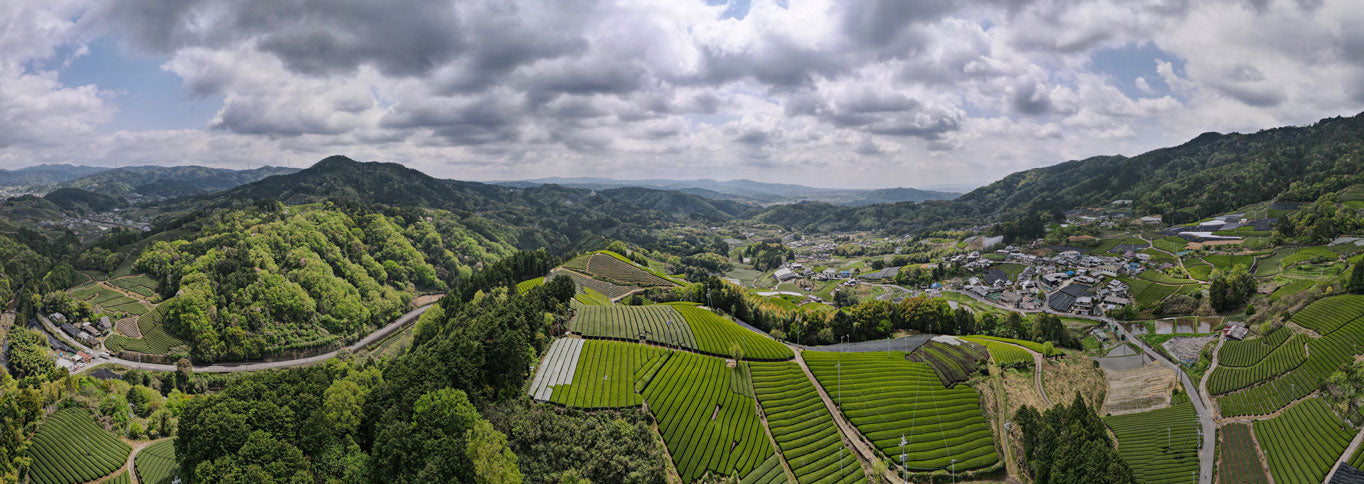Japanese tea is known worldwide for its unique quality and fresh taste. The East Asian country has a long tradition of tea production and offers a wide variety of types and varieties. Two terms that often appear in connection with Japanese tea are "Aracha" and "Shiagecha". In this blog article, we will explain the terms and find out how much effort goes into producing top-quality tea.
How is tea actually made in Japan?
Japanese tea farmers usually have a tea garden or a plot of land on which they grow tea. They either process the harvested leaves themselves into "Aracha" or they deliver them to a cooperative that processes their leaves. The name "Aracha" literally means "raw tea" and refers to the state of the tea after steaming and rolling the leaves. Aracha is unsorted after production and therefore contains stems, leaves of all sizes and occasionally foreign bodies. As the name suggests, this is not yet the finished product, even if you could already make green tea from it.
What happens to the raw tea afterwards?
Some tea farmers sort their tea themselves as best as their machinery allows. The same applies to roasting and mixing different components. Depending on the tea farmer's capabilities, this produces green teas that lie in the grey area between Aracha and Shiagecha, the "refined tea".
As a rule, however, Aracha is offered at auction fresh after production. There are also cases where a tea farmer sells the tea directly to a Japanese tea manufacturer at a previously agreed price. The manufacturers buy a large number of such batches across the country and use their know-how and the appropriate technology to turn this intermediate product into processed tea.
The processing of Aracha into Shiagecha
Once the Aracha tea has been harvested, it is further processed to produce the higher quality Shiagecha tea. The processing of Aracha into Shiagecha involves various steps such as sorting, roasting and removing stems and unwanted leaf parts. This process aims to produce a visually appealing and taste-balanced and high-quality tea. The tea maker plays a central role in the production of Shiagecha. From the available harvests, he or she must select the most suitable from a variety of cultivars that together create a small work of art of cup color, scent, taste, sweetness and umami. For this, it is not only important to know which cultivars harmonize with each other and how, but he or she must also know how to maintain the delicate balance every year. Depending on the recipe and target market, for example, leaf breakage may be deliberately added to emphasize the body of a tea or a batch may be roasted more intensely to give a tea more complexity.
But even the best harvests from a garden or a tea farmer benefit from professional processing, as they look much cleaner and more uniform through the use of professional sorting systems such as color sorters or electrostatic sorting machines. In addition, the smell and taste can be further intensified through targeted roasting using special roasting drums, hot air or infrared.
The Taste of Aracha vs. Shiagecha
For this reason, Aracha tea is often less complex and unbalanced and does not offer the same depth as the refined tea. However, it is signifitintly cheaper in comparison. With Shiagecha, special emphasis is placed on ensuring that the appearance, smell, cup color and, above all, taste are convincing and balanced. The experienced tea maker develops the full potential of the individual components and combines them into a cuvée in which emphasis can be placed on fruit notes, roasted aromas, vegetable sweetness or umami.
And what do you find at TeeGschwendner?
All teas in our premium range are refined teas made according to a recipe we have defined. This allows us to guarantee a stable taste over the years that tin only be found in this form with us. While a tea like Sencha Extra Fine, No. 705 tin come from different prefectures, there are also green teas like our Shincha that come from just one family. But we also have these selected, homogenized and re-roasted according to our specifications in order to fully exploit their potential. And you can taste the difference!



Leave a comment
This site is protected by hCaptcha and the hCaptcha Privacy Policy and Terms of Service apply.